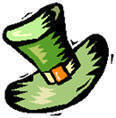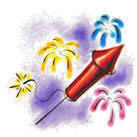Founded in 1966 by Dr. Maulana Karenga, a professor and chairman of Black Studies at California State University, Long Beach, Kwanzaa is a non-religious holiday created to promote social and family values and appreciation of African American heritage. The word "Kwanzaa" was derived from the Kiswahili for "first fruits": "matunda ya kwanza", with "kwanza" meaning "first". Richly symbolic, Kwanzaa is patterned loosely after African harvest celebrations from various African cultures. The seven days of the celebration represent the seven principles, or Nguzo Saba:
The ritual elements and activities of Kwanzaa are also symbolic. For example, the wooden candle holder, or kinara, decorating the feast table is said to represent the stalk or beginnings, meaning African American ancestry. Each of the seven candles (Mishumaa Saba) that the kinara holds represents one of the principles. Other symbols of the holiday include Mazao (the crops), the harvest & the rewards of labor; Mkeka (the mat), the foundation of tradition and history; Muhindi (the corn), children and the future; and Kikombe cha Umoja (the Unity Cup), the practice of unity. Kwanzaa is a time for families to gather together. During Kwanzaa family members exchange gifts, preferably homemade, that relate to their African ancestry. Examples include clothes, cloth dolls, pottery or carved wood decorations, and necklaces. And each evening there is a special activity (such as a song, story or play) that is related to the principle celebrated that night. On the last night of Kwanzaa, December 31st, a great feast is held. To learn more about the history and symbols of Kwanzaa, see our links below, under Social Studies. Be sure to browse other parts of this page for arts and crafts ideas, lesson plans, and book recommendations.
Reading
Lots of traditional tales, including some Anansi stories:
Nigerian Folktales for Children Dozens of stories to share with kids, and even make into plays.
African Stories written by Ugandan Children Use these to inspire students to write their own tales!
Writing & Related
Word jumbles, word searches, crosswords, and more!
Kwanzaa Worksheet (grades 3-5)
Holiday Comparison Have students think about different holiday celebrations. How are they similar to or different from Kwanzaa? Consider food, decorations, principles and meaning, and activities.
Kwanzaa Word Search (grades 2-5) For the answer key, click here
Kwanzaa Word Search II (grades 6-8) For the answer key, click here
Songs, & Fingerplays
Science
Social Studies
Although created in 1966, Kwanzaa is filled with ritual, symbolism, and values that evoke centuries of African culture and tradition. In its gentle way, it serves to remind everyone that black Americans have a vast and complicated legacy. That is, before the modern "gansta" street culture glorified by rappers and MTV, and before the centuries of social and political repression that accompanied slavery and white domination, African Americans held complex and varied cultural traditions, which had been brought with their ancestors on the slave ships that crossed the Atlantic.
But by the mid 20th century, when black Americans finally began to find some measure of freedom, for both self expression and self determination, much of this rich heritage had been lost. Instead a "poverty of culture" surrounded many: violence, alcoholism, poor or nonexistent education, desperate scrabbling after low wage jobs, absentee fathers, and fear of violent racial discrimination. And above it all, the sense that opportunities were limited, that a multitude of factors conspired with racial bigotry to keep black Americans from bettering themselves. Meanwhile those few who managed to pull themselves out of poverty, out of the ghettos, out of the cotton and tobacco fields, found that education and higher culture meant an immersion in European style literature, values, and images. All the faces of beauty, of learning, of better things, seemed white. Somehow, this only reinforced the painful legacy of poverty and slavery. As if black Americans were but creatures of darkness and ignorance, earning the right to enter a white world. But had they not given that same world Jazz, the Blues, and Rock and Roll? Uniquely African American aesthetics and artistic traditions had significantly infused American pop culture --even if white Americans, co-opting those innovations had often received the credit, and the cash. And what about black innovators in science, engineering, and medicine? The dedication and ingenuity learned in overcoming terrible adversity had equipped the likes of George Washington Carver, Garrett Morgan, and Dr. Charles Drew and many others to make impressive contributions that profoundly impacted American lives. Yet at the time one almost never heard of them. Even in the fields of sports, black Americans of tremendous accomplishment had a difficult time gaining the recognition and respect they deserved. Clearly people of African American descent had much to offer, and much to be proud of. But few people, white or black, seemed to know this. For decades the white dominated media saw to this, intentionally or by unquestioned habit. But then in the 1960s and '70s, on the cresting wave initiated by the Civil Rights movement, expressions of black power and value began to infiltrate the larger culture. "Black is beautiful" became the rallying cry. But what did it mean to be a black American? And how could black Americans support each other, and teach their children to value themselves -- to love themselves as themselves, not as white imitators. Surely embracing their distinctly African heritage was key to this, just as white Americans valued and promoted their varied European legacies. A passion and burgeoning interest in African literature and mythology, music and dance, fashion, and tradition was born. And out of this, came Kwanzaa.
Kwanzaa, A Celebration of Family, Community and Culture
Learn about the Kwanza on
its official website. Includes history of the holiday,
guidelines on celebrating, and speeches from founder
Dr. Maulana Karenga. Video -- The History of Kwanzaa Learn about the holiday's connection to the Civil Rights Movement and African culture. From the History Channel. (You'll have to sit through a brief commercial before it begins.)
History of the Civil Rights Struggle From the early days of American slavery through the Civil War, to modern day America this site offers a helpful overview of the arduous journey toward racial equality. Features videos, maps, and more. From the History Channel.
A brief but informative overview that will tell you just what you need to do to hold your own Kwanzaa celebration. Includes the symbolic decorations, the feast, even what needs to be said.
A mouth-watering collection of traditional African American recipes to help students immerse themselves in the culinary culture of the holiday. Includes lots of vegetarian recipes.
Maps, climate, population, languages, history-- all you want to know about each nation!
Statues, masks, drums, baskets, and more.
Math You can count to ten in Kiswahili !
Art
More Lesson Plan Ideas Kwanzaa: A Holiday of Reflection and PurposeThis is lesson five of the So Many Ways to Celebrate unit. Students will learn about Kwanzaa and why it is celebrated. Students will then view Web sites that describe the holiday in more detail and will participate in an activity in which they celebrate their own heritage.
Links to further information on key topics from Slavery, Segregation, and the Civil Rights Movement to the social impact of African American involvement in sports and music.
|
MORE Fun &
Learning
Kids Can...
Giving Service
Taking a Stand
Against
Taking A Spiritual
Empowering Children
PARENTS
Guidance & Positive
Discipline
Sensory Materials
|
|
Check out our great
Earth's
Kids
Kids
Can Change the World
action pages and Valentine's Day, Easter and Saint Patrick's Day pages for science and craft activities, reading and more!
Every
day is
EARTH
DAY!
Check
out our great fun
activities, art, & learning Wondering about the weather? Don't miss the Earth's Kids special feature on Climate Change & Global Warming!
Learn how to keep your
children safe in the event of a natural disaster. Tips to Teach Kids How to Wash Hands!
|
Copyright Earth's Kids 1999. All rights reserved.











